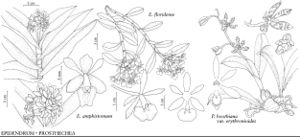Epidendrum
Syst. Nat. ed. 10, 2: 1246. 1759.
| Taxon | Illustrator ⠉ | |
|---|---|---|
 | Epidendrum amphistomum Epidendrum floridense Prosthechea boothiana var. erythronioides | Barbara Alongi Barbara Alongi Barbara Alongi |
Herbs, epiphytic, rarely lithophytic, cespitose. Roots fleshy, glabrous. Stems erect, repent, or hanging, canelike, simple or branching. Leaves alternate; petiole tubular, sheathing, articulate; blade ovate to elliptic or lanceolate, fleshy-leathery. Inflorescences terminal [lateral or basal], racemose to nearly corymbose or distichous, producing flowers only once, or during several years from same or new racemes from old axis; flowers pedicellate or not. Flowers resupinate or not, if not then distichous or spirally arranged, simultaneous or successive; sepals nearly equal; lip adnate to column throughout, forming nectary tube, tube penetrating ovary, occasionally producing nectar; column straight or slightly arched; clinandrium hood partly covering anther; anther 4-celled; pollinia 4, obovoid, laterally compressed, nearly equal; rostellum slit, producing semiliquid viscidium attached to caudicles of pollinarium. Fruits capsules, ellipsoid to subglobose, sometimes with pedicel or beak, 3-ribbed, 1-locular.
Distribution
Tropical regions, Western Hemisphere
Discussion
Species over 1000 (7 in the flora).
Outside the flora area Epidendrum is highly varied (E. Hágsater 1984), sometimes producing pseudobulbs or thickened stems, semiterete to membranaceous leaf blades, and apical, lateral, or basal, racemose to nearly corymbose to paniculate inflorescences. The lip of the flower is adnate to the column, forming a nectary tube, but it rarely produces nectar. The lip is exceptionally distinct and free. The rostellum is always slit, producing a transparent or whitish semiliquid viscidium. The pollinarium usually has 4 pollinia, sometimes with 2 very reduced, rarely with only 2.
The Florida species were segregated into 2 genera, Amphiglottis and Spathiger (J. K. Small 1933). Later authors have recognized only Epidendrum.
Selected References
None.
Lower Taxa
Key
| 1 | Plants creeping or hanging, ± branching; inflorescences distichous. | > 2 |
| 1 | Plants cespitose, aerial stems erect, unbranched; inflorescences nearly racemose or nearly corymbose. | > 4 |
| 2 | Plants hanging, main stem greater than 40 cm; inflorescences distichous-imbricate; sepals greater than 12 mm. | Epidendrum acunae |
| 2 | Plants creeping, main stem less than 20 cm; inflorescences distichous-elongate or distichous-imbricate; sepals less than 8 mm. | > 3 |
| 3 | Inflorescences distichous-elongate, equal to or greater than 5 cm; flowers mostly more than 5, sepals 5 mm. | Epidendrum rigidum |
| 3 | Inflorescences distichous-imbricate, less than 3 cm; flowers usually 3, sepals 3 mm. | Epidendrum strobiliferum |
| 4 | Inflorescences 3–50 cm (excluding flowers), racemose or compound racemose; sepals 5–11 mm. | > 5 |
| 4 | Inflorescences less than 3 cm (excluding flowers), nearly corymbose; sepals equal to or greater than 12 mm. | > 6 |
| 5 | Inflorescences racemose; flowers spread out along apical 1/2 of inflorescence; sepals 6–11 mm. | Epidendrum magnoliae |
| 5 | Inflorescences racemose, compound racemose with time; flowers in compact short racemes at end or from nodes of long peduncle; sepals 5.5–7.5 mm. | Epidendrum amphistomum |
| 6 | Sepals 60 mm; flowers yellowish and white, flowering successively, 1–2 at a time. | Epidendrum nocturnum |
| 6 | Sepals 12–15 mm; flowers green, flowering simultaneously, 4–14. | Epidendrum floridense |